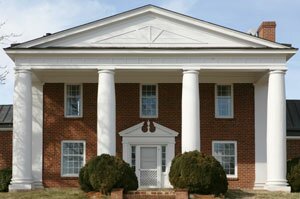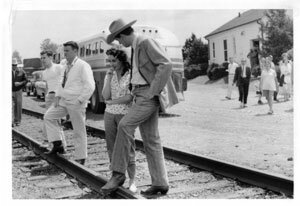Giant symbols: Belmont manor plays its part
When Rock Hudson came to Charlottesville to shoot the opening scenes of George Steven's classic 1955 movie, Giant, he landed at a luxurious Keswick mansion that was supposed to speak volumes about horse country. Now that the mansion is for sale, some architectural critics note that the mixed architectural message speaks volumes about human vanity.
Hudson was impressed by the shooting location even though in the movie the Virginia scenes are described as being in Maryland.
"He telephoned me with glowing reports," writes Phyllis Gates in her book, My Husband, Rock Hudson, "...of lush pastures, the white rail fences, the beautiful thoroughbred horses, the stately houses. 'Even the motel where I'm staying looks like a colonial mansion,' he said."
Rock wasn't quite as taken with Texas, where the majority of Giant was filmed, or with co-star James Dean. According to Gates, her husband "hated" James Dean and thought he was a "poseur and a malingerer" who was going to steal the picture from him.
Hudson's jealousy (or was it attraction, given what we know now?) of Dean was so intense that he often wished him dead during the making of Giant, Gates says. When Dean crashed his Porsche Spyder and died seemingly on cue after the picture was finished, Hudson was so racked with guilt and shame that he fell into a dark depression. But that's another story.
Stevens most likely chose Charlottesville as his stand-in for Maryland because of its "stately houses" and "lush pastures." As those who've seen the movie know, Hudson's character comes to "Maryland" to visit a wealthy family at their mansion, "Ardmore." Hudson is there to buy a thoroughbred horse, but also winds up wooing their daughter, played by Elizabeth Taylor, and brings both back to Texas.
According to architectural historian Calder Loth, the house Stevens shot, Belmont in Keswick, was his first choice. Today, the historic manor home, along with 23 acres, is listed for sale for a mere $2,950,000.
"The house was probably chosen because it looked good from a distance," says Loth, "and was in a bucolic landscape setting." Indeed, with its grand four-column portico, Belmont does look like one of those stately houses that so impressed Hudson. But on closer inspection, Belmont appears to be more like a movie set than a stately manor.
Loth says that historical records indicate the original mid-18th century dwelling– a farmhouse of just a story and a half– was chopped up in the 1850s and used to create a series of outbuildings when a new mansion took the site.
Designed in Classic Revival-style, Belmont came complete with a grand hall for dancing, a 1,500-gallon water tank in the roof for hot and cold running water, and a furnace in the basement that heated the whole house.
"Certainly no country house equaled it in that day," writes Edward C. Mead in his book, Historic Homes of the South-West Mountains, Virginia. Unfortunately, the mansion burned in an 1883 fire, so the old house was– believe it or not– reassembled on its original site, more or less, but with two stories and a two-level portico.
Classic Revival invoked the simplicity and grandeur of Rome, but in the 20th century, America witnessed an unfortunate outbreak of Anglophilia and a revival of Georgian architecture.
Loth believes the Georgian pediment was added over the entryway in the 1950s. "The house looks good from a distance," he says, "but the 1950s' detailing is not sophisticated."
Noted architectural historian Richard Guy Wilson concurs. "The combination of a four-column portico and a broken pediment door is unorthodox," he says, " but there is lots of that around. It's a sort of showing off."
Which, of course, made it a perfect setting for a Hollywood movie; and more specifically, for Liz Taylor's highbrow character in Giant.
To a young and casual observer like Hudson, and to many casual observers after him, Charlottesville has always been characterized– dare we say, type-cast?– by these stately, columned manor houses with their lush, rolling pastures. There's a perceived status associated with such images, a status that director Stevens hoped to capture in Giant, and that Hudson picked up on during his brief stay.
But status symbols can be deceptive. In Giant, James Dean's rags-to-riches character acquires all the many status symbols of wealth– he even has an airport named after him– but none of it is enough to break the class barriers that would make him a candidate for Liz Taylor's affection.
In Charlottesville, estates like Belmont would seem to characterize the upper-class world that Taylor's character inhabits (and they once did), but in reality it may be nothing more than an expensiveand some might say low-brow façade.

Belmont manor in Keswick was a stand-in for a Maryland manor house in the 1955 movie, Giant
PHOTO BY BILLY HUNT

Giant stars: Local legendary photographer Ed Roseberry catches Elizabeth Taylor and Rock Hudson on a break between scenes. The old train depot in Keswick was also used as a location.
PHOTO BY EDWIN ROSEBERRY
#